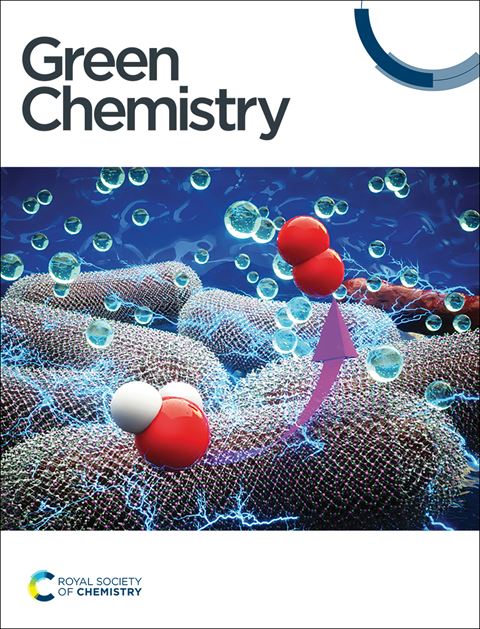增强底物富集深度催化氧化脱硫的笼型-核-链结构催化剂的设计
IF 9.3
1区 化学
Q1 CHEMISTRY, MULTIDISCIPLINARY
引用次数: 0
摘要
开发集靶分子富集和活性氧生成于一体的复合金属-有机框架(MOF)催化剂以提高油水两相脱硫效率仍是一个挑战。通过将磷钨酸(HPW)芯封装在MIL-101(Fe)笼内,接枝[Bmim]+链(疏水离子液体基团),设计了一种“笼-核-链”结构的功能催化剂[Bmim]PW@MIL-101(Fe)。W-O-Fe键促进电子转移,重新分配电荷密度,并活化过氧乙酸。Fe3+/Fe2+氧化还原循环促进活性氧的生成和转化,单重态氧(1O2)是主氧化剂。密度泛函理论(DFT)计算证实了核壳间电荷密度的变化和活性氧的生成途径。此外,该催化剂在固油-水界面处创造了微油环境,增强了二苯并噻吩(DBT)的富集及其与活性氧的相互作用,DBT的去除效率是MIL-101(Fe)的近3.5倍。这项工作为激活活性较低的mof中的催化位点提供了一种可持续的策略,为清洁燃料生产提供了有效的脱硫方法。本文章由计算机程序翻译,如有差异,请以英文原文为准。
Design of a cage–core–chain structure catalyst for deep catalytic oxidative desulfurization with enhanced substrate enrichment†
Developing composite metal–organic framework (MOF) catalysts that integrate target molecule enrichment and reactive oxygen species generation to enhance oil–water biphasic desulfurization efficiency remains challenging. A “cage–core–chain” structured functional catalyst, [Bmim]PW@MIL-101(Fe), was designed by encapsulating a phosphotungstic acid (HPW) core inside an MIL-101(Fe) cage and grafting [Bmim]+ chains (hydrophobic ionic liquid groups) onto it. The W–O–Fe bond facilitates electron transfer, redistributes charge density, and activates peracetic acid. The Fe3+/Fe2+ redox cycle promotes the generation and transformation of reactive oxygen species, with singlet oxygen (1O2) as the primary oxidant. Density functional theory (DFT) calculations confirm charge density changes between core and shell, and active oxygen generation pathways. Additionally, the catalyst creates a micro-oil environment at the solid–oil–water interface, enhancing the enrichment of dibenzothiophene (DBT) and its interaction with reactive oxygen species, achieving nearly 3.5 times the DBT removal efficiency of MIL-101(Fe). This work provides a sustainable strategy for activating catalytic sites in MOFs with inherently low activity, offering an efficient desulfurization approach for cleaner fuel production.
求助全文
通过发布文献求助,成功后即可免费获取论文全文。
去求助
来源期刊

Green Chemistry
化学-化学综合
CiteScore
16.10
自引率
7.10%
发文量
677
审稿时长
1.4 months
期刊介绍:
Green Chemistry is a journal that provides a unique forum for the publication of innovative research on the development of alternative green and sustainable technologies. The scope of Green Chemistry is based on the definition proposed by Anastas and Warner (Green Chemistry: Theory and Practice, P T Anastas and J C Warner, Oxford University Press, Oxford, 1998), which defines green chemistry as the utilisation of a set of principles that reduces or eliminates the use or generation of hazardous substances in the design, manufacture and application of chemical products. Green Chemistry aims to reduce the environmental impact of the chemical enterprise by developing a technology base that is inherently non-toxic to living things and the environment. The journal welcomes submissions on all aspects of research relating to this endeavor and publishes original and significant cutting-edge research that is likely to be of wide general appeal. For a work to be published, it must present a significant advance in green chemistry, including a comparison with existing methods and a demonstration of advantages over those methods.
 求助内容:
求助内容: 应助结果提醒方式:
应助结果提醒方式:


